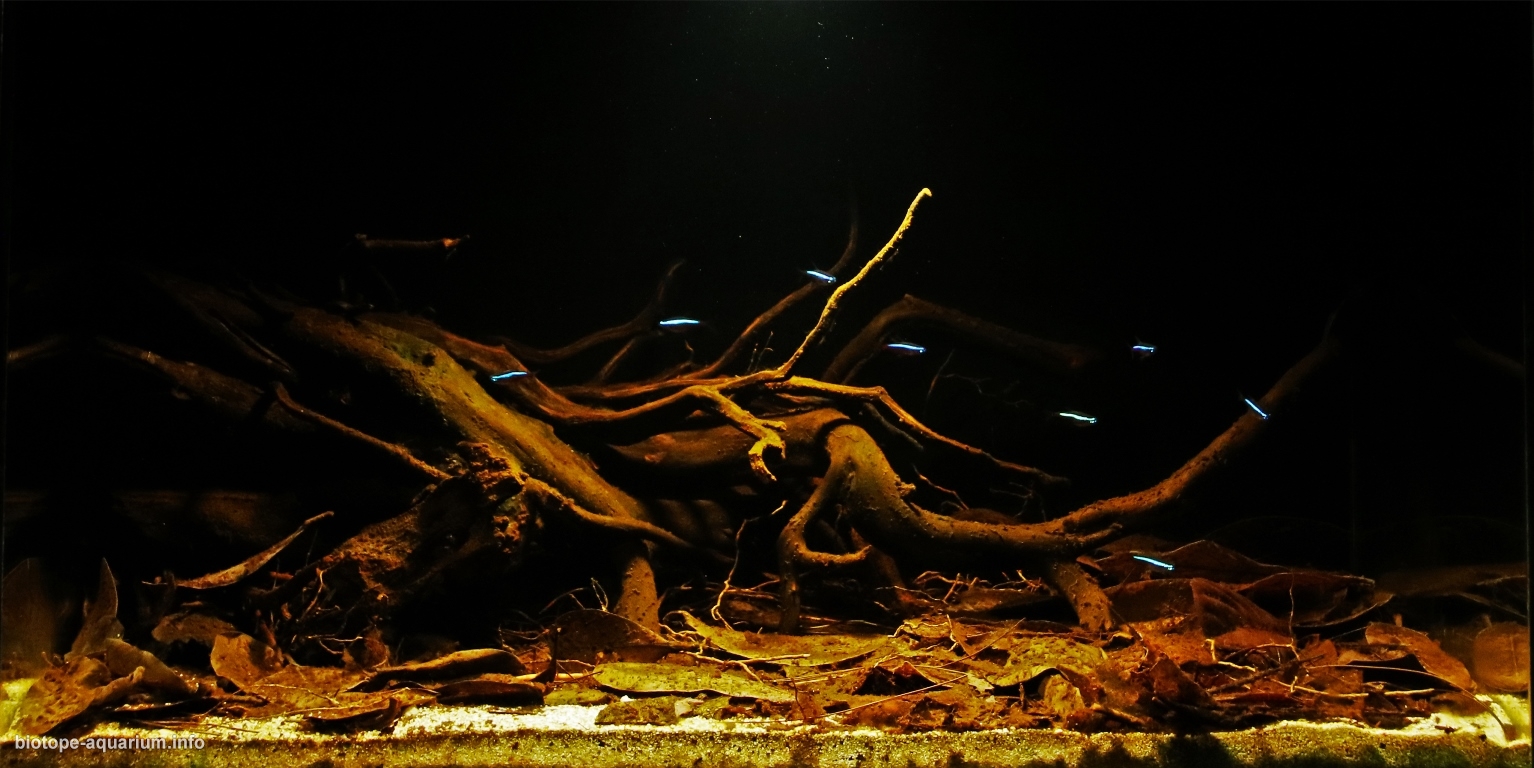Igapó Forest Near Downstream Area of Rio Demini, Amazonas, Brazil
_th place in Biotope Aquarium Design Contest 2020

Volume: 74 L
Dimensions: 60x35x35
List of fishes: Paracheirodon Axelrodi
List of plants: N/A
Description of decorations: The substrate is made of fine sand that i bought from local fish store. Cattapa and jackfruit leaves are used for leaf litter to simulate natural biotope. I collected driftwood, leaves and branches from the local river. Some driftwood were purchased in LF known as rasamala wood.
Description of equipment: DIY external sump filter with Sunsun RPS1000 for return pump. waterflow about 350-400L/h. LED Bulb 12,5 watt, 6000 kelvin, 1800 lumen.
Water parameters: Transparent water stained with yellow-brown tones. pH 6.5, GH 4. Temprature about 26°C- 27°C
Additional info: 20%-30% waterchange every weeks.
Additional water in external sump about 25L
INFORMATION ABOUT BIOTOPE:
Description of the area surrounding the biotope: Rio Demini is a river in the Amazon rainforest of the state of Amazonas, Brazil. It is a northern tributary of the Rio Negro and joins the latter near Barcelos,. The Demini River is originated in the Serra do Araca State Park, with an area of approx. 1,820,000 hectares of catchment. As one major tributary of Rio Negro, Rio Demini has a lot of slow streams flowing through the rainforest. The whole catchment in both Rio Negro and Rio Demini is covered by thick vegetation, which makes the color of water brownish due to fallen tree leaves.
During the period of inundation small fishes move upstream within the river’s tributaries and then laterally into the flooded forest itself to feed and reproduce, before returning to the tributaries when the waterlevel drops.
The rainy season is not the same for the whole basin, at Barcelos, about 500 km in the northwest direction, the rainy period goes from April to June, with maximum precipitation in May.
igapó is a word used in Brazil for blackwater-flooded Amazonian forests. These forests are seasonally inundated with freshwater. They typically occur along the lower reaches of rivers and around freshwater lakes. Igapó is primarily characterized by seasonal inundation caused by abundant rainfall; in some areas, trees can be submerged for up to 6 months of the year.
Description of the underwater landscape of the biotope: Igapó forests are characterized by sandy acidic soils that have a low nutrient content. The color and acidity of the water is due to the acidic organic humic substances (e.g. tannins) that dissolve into the water. Igapó near downstream area of Rio Demini also characterised by thick, often overhanging, riparian vegetation and substrates covered in fallen branches, tree roots and leaf litter. These waters are sheltered by Igapó trees, and the underwater light is dark and distinct.
Description of the parameters of the habitat: Some characteristics of the Rio Negro are: bed stability, with low erosion; extremely weathered podzolic soil; de-pleted aquatic fauna and flora; low concentration of dis-solved salts and absence of suspended matter; low pH; and an intense color, ranging from dark brown to black, due to high concentrations of humic compounds. The low sediment load permits the high concentrations of humic acid and fulvic acid in solution, as humic compounds would adsorb on particles, if present. Amazonian stream with similar characteristics are called Igarapé and Igapó for blackwater flooded forest
Most rivers have high organic carbon (DOC) concentrations. DOC concentrations in Rio Negro Basin (11.4 mg L-1). The pH in the Negro Basin (3.89-6.07). The pH in the Rio Demini (3.96-5.26). The temperature of water is about 22-24 degrees Celsius in rainy season
List of fishes and invertebrates occurring in the nature biotope: Apistogramma Spp, Paracheirodon Axelrodi, Hemigrammus bellottii, Hemigrammus ocellifer, Crenicichla Notophthalmus.
List of plants found in the nature biotope: Igapó trees block a lot of light coming into the water column. Many of these igapó areas don’t have much vegetation growing submerged
Threats to the ecology: Agricultural expansion and intensification are major threats to tropical biodiversity. In addition to the direct removal of native vegetation, agricultural expansion often elicits other human-induced disturbances, many of which are poorly addressed by existing environmental legislation and conservation programmes. This is particularly true for tropical freshwater systems, where there is considerable uncertainty about whether a legislative focus on protecting riparian vegetation is sufficient to conserve stream fauna.
Sources of information:
http://www.roggo.ch/
https://rainforests.mongabay.
https://www.
